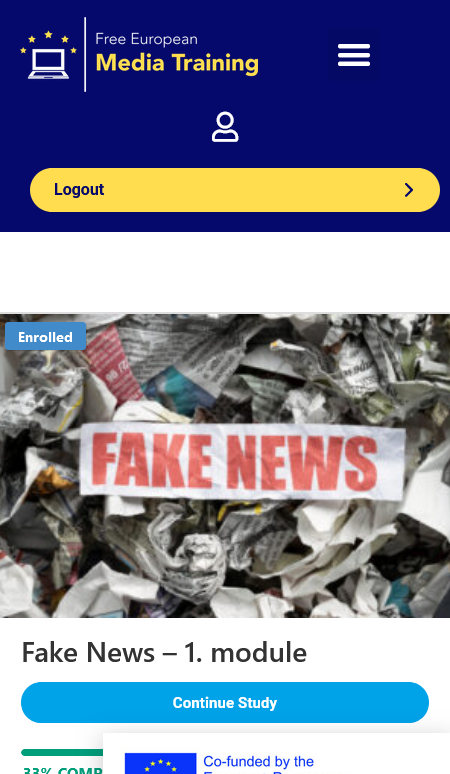on developing soft skills for critically analyzing the use of media. Our primary objective is to equip participants with the knowledge and skills to discern whether information is real and accurate or not.
Our training course will start with an introduction to different media outlets and their scales. We will then move on to explore various types of media, including news, fake news, deep fake, and so on. By the end of this course, we aim to provide you with the ability to categorize and distinguish between these types of media.
We believe that the latest IT methods are essential in reaching our target audience. That’s why we have developed a course that incorporates a variety of resources, including videos, written materials, and questionnaires to check your development.
By emphasizing conscious information consumption, we hope to contribute to a sustainable, free, and reliable media.


Our course curriculum also includes developing skills on the proper usage of social media. By doing so, we aim to enhance the importance of communication and strengthen cross-sectorial policies. This course is an excellent opportunity for adults searching for ways to expand their knowledge and take part in online education.
Additionally, this project serves as an excellent opportunity to support high-school students in developing skills to make conscious choices in information consumption, thus contributing to civic and EU knowledge and integration lessons.
Click on the module number and learn more about it!
In this module, we delve into the pervasive issue of fake news and its impact. We explore how fake news, far from being harmless, can have serious consequences like spreading medical hoaxes, affecting minds in warfare, and causing substantial financial losses. According to an MIT study, fake news spreads six times faster than the truth, highlighting the risks of misinformation nesting in our minds. We also examine the alarming rise in social media scams, with losses skyrocketing over four years. The chapter emphasizes that no one, regardless of education or intelligence, is immune to the allure of fake news, which often aligns with personal beliefs and worldviews. Through examples, we underscore the importance of critical thinking and recognizing our own susceptibility to misinformation. This chapter sets the foundation for understanding the importance of discerning fact from fiction in our increasingly digital world.
Module 2 of the e-learning course focuses on critical analysis of news sources. It uses practical examples like the sensational claim about Russian scientists cloning ancient warriors to teach how to verify news authenticity. Students are guided on how to check the credibility of sources, identify emotional manipulation in articles, and understand the importance of cross-referencing information. The module also emphasizes the need for skepticism towards seemingly sensational news and the importance of tracing the chain of sources to uncover potential misinformation or manipulation. These skills are vital in an era where fake news can spread rapidly across various media platforms.
Module 3 explores the complex nature of fake news and its varying degrees of subtlety. Emphasizing that no one is completely immune to misinformation, the module guides learners through a ‘treasure hunt’ game to identify subtle clues indicating news authenticity. It highlights that for more sophisticated disinformation, basic debunking techniques may not suffice, as they often include credible sources and evoke emotions like compassion or admiration. The module demonstrates how to critically analyze sources and maintain objectivity, using an example debunked by Snopes.com. Key takeaway: always maintain a cool head and be wary of news that triggers strong emotional responses.
Module 4 of the e-learning course addresses the power and potential deception of images in news. It emphasizes that images, often more impactful than text, can mislead and manipulate public perception. Through interactive exercises, learners are taught to critically analyze images, using real-world examples like misleading photographs related to COVID-19 or artificially generated images of public figures. The module highlights the importance of self-reflection, especially in reacting to strong images, and provides practical tips on verifying image authenticity. It also touches on the emerging challenge of deep fake technology, stressing the importance of source validation in the digital age.
Module 5 delves into understanding the motivations behind the spread of fake news, highlighting both financial and political incentives. It discusses how fake news has evolved into a profitable industry, with examples ranging from promoting products with false claims to manipulating public opinion for political purposes. The module emphasizes the importance of asking “why?” when encountering suspicious news, teaching learners to discern the underlying intentions, whether it’s misinformation for profit or political disinformation. The module also covers tactics used in warfare propaganda, like the Russia-Ukraine conflict, demonstrating how disinformation aims to create confusion and skepticism among the public. Ultimately, it encourages a balanced approach to news consumption – staying informed while maintaining a healthy level of skepticism.
Module 7 explores the complex and ever-evolving media landscape, highlighting the blurring lines between traditional and modern media. It addresses the rise of digital platforms, social media, mobile media, and the significance of user-generated content and streaming services. The module also delves into the challenges of misinformation, particularly focusing on deepfake technology and its implications. It offers practical strategies for selecting and filtering news, emphasizing the importance of source credibility, fact-checking, and critical thinking in discerning real news from fake. The module underscores the need for media literacy and a balanced approach to consuming information in the digital age.




Join our free e-learning training course today and equip yourself with the essential skills to navigate the media landscape consciously.

All rights reserved Free European Media | The website was created by Prosum in 2023.

